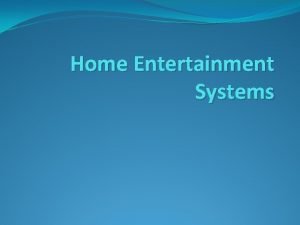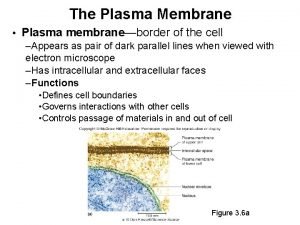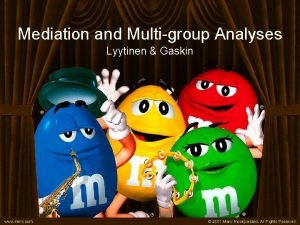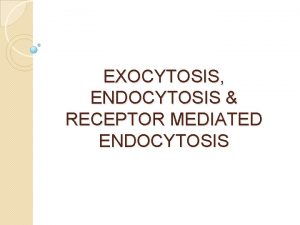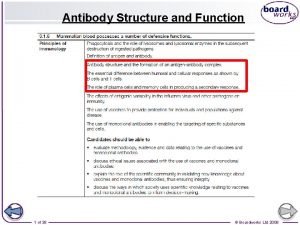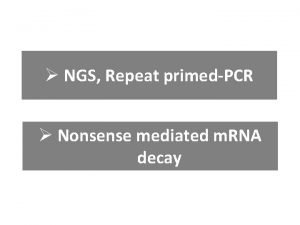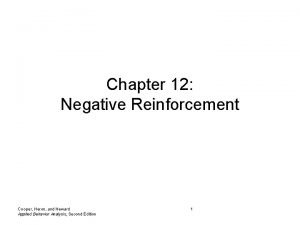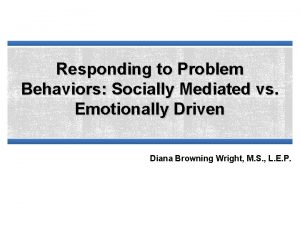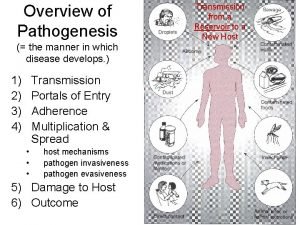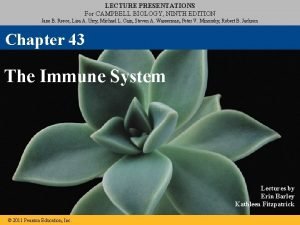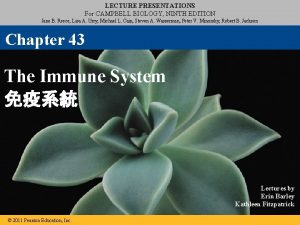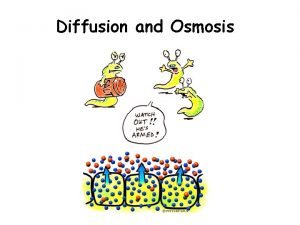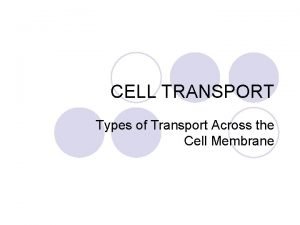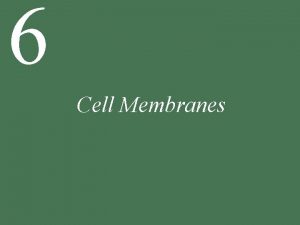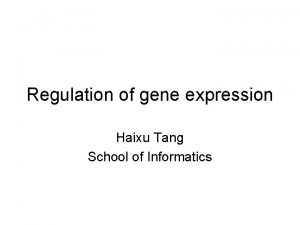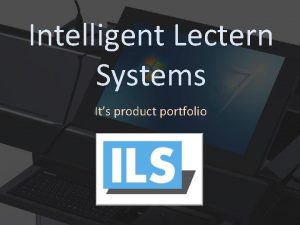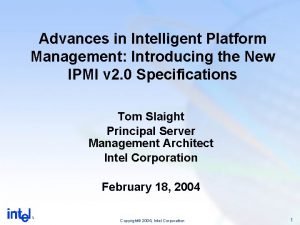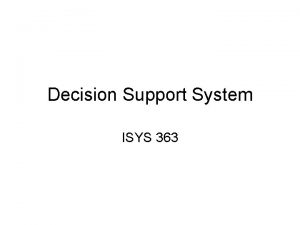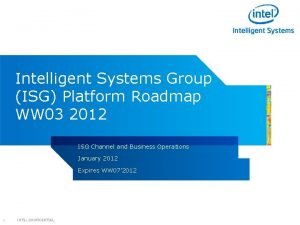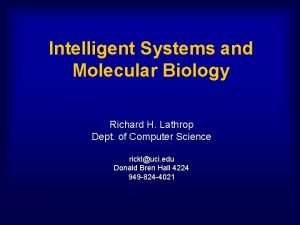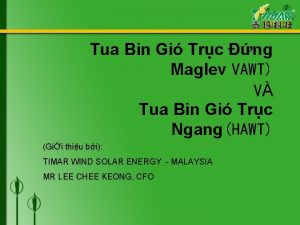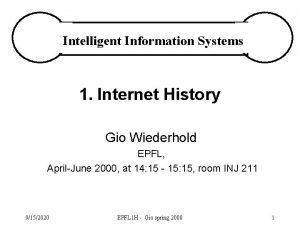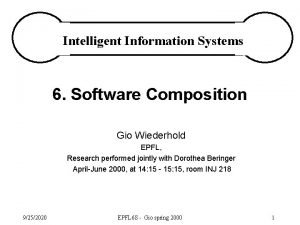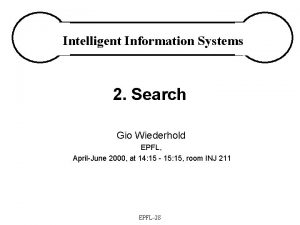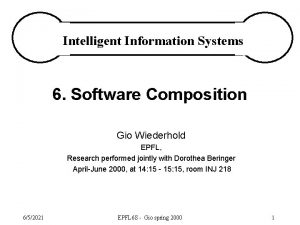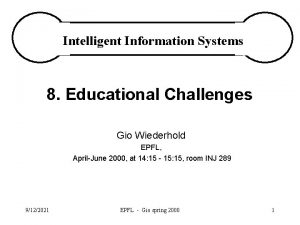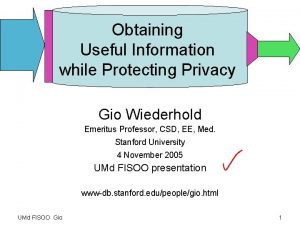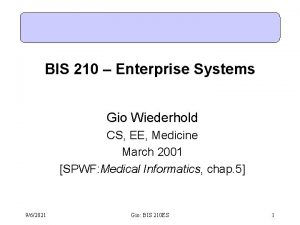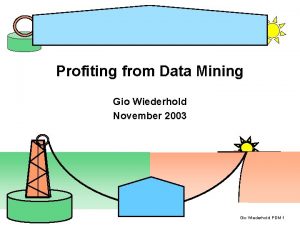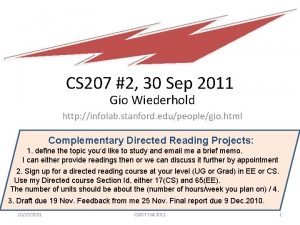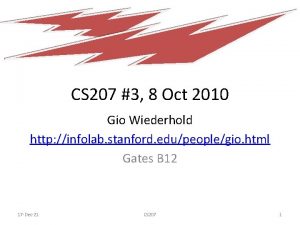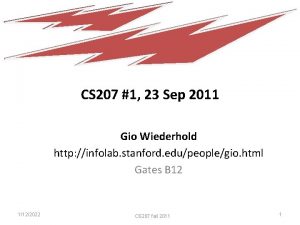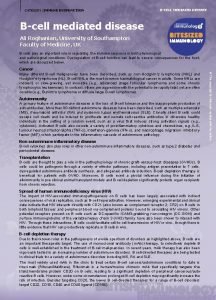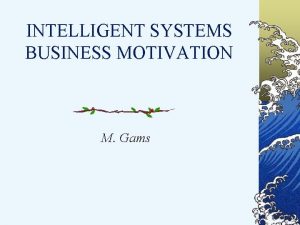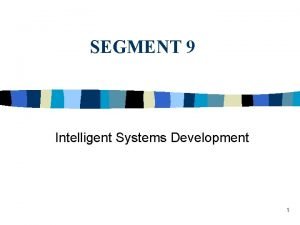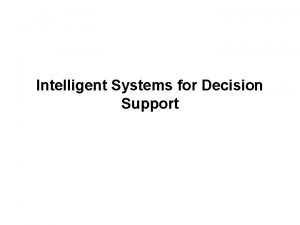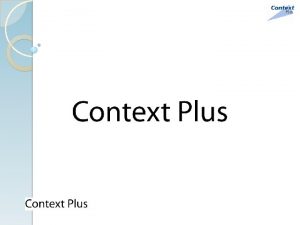Intelligent Information Systems 5 Mediated Sytems Gio Wiederhold



































- Slides: 35

Intelligent Information Systems 5. Mediated Sytems Gio Wiederhold EPFL, April-June 2000, at 14: 15 - 15: 15, room INJ 288 EPFL 5 mediators

Schedule Presentations in English -- but I'll try to manage discussions in French and/or German. • I plan to cover the material in an integrating fashion, drawing from concepts in databases, artificial intelligence, software engineering, and business principles. 1. 13/4 Historical background, enabling technology: ARPA, Internet, DB, OO, AI. , IR 2. 27/4 Search engines and methods (recall, precision, overload, semantic problems). 3. 4/5 Digital libraries, information resources. Value of services, copyright. 4. 11/5 E-commerce. Client-servers. Portals. Payment mechanisms, dynamic pricing. 5. 19/5 Mediated systems. Functions, interfaces, and standards. Intelligence in processing. Role of humans and automation, maintenance. 6. 26/5 Software composition. Distribution of functions. Parallelism. [ww D. Beringer] 7. 31/5 Application to Bioinformatics. 8. 15/6 Educational challenges. Expected changes in teaching and learning. 9. 22/6 Privacy protection and security. Security mediation. 10. 29/6 Summary and projection for the future. • Feedback and comments are appreciated. 12/27/2021 EPFL 5 mediators 2

The world wide information network and its participants _ …. _ External: …. sources and / or sinks _ …. _ _ …. …. _ data, meta-data, knowledge _ …. _ _ …. …. _ …. …. 12/27/2021 EPFL 5 mediators _ …. Internal: transformers and memory. 3

Understand the Architecture for Information Technology: Component Classification Customers Customers Services Sources 12/27/2021 EPFL 5 mediators 4

Example in Health Care Planner Will the Clinic loose Money? Investment domain Patient Care domain Age Profile Service Operations Patient Volume Growth 12/27/2021 Loan Interest Bond Sales State Support

Specifications for the components Customer models s o Pr s re g Sources 12/27/2021 Customers Customers Services Catalogs Content & Methods Metadata EPFL 5 mediators 6

Service layer Multiple domains ! Customer Service MEDIATION Resource access 12/27/2021 EPFL 5 mediators Shared software, standards ? 7

Value-added intermediate services 1 Needs Technologies extant and new Describe customer Build interpretable workflow model with model meta-specifications for selection Discover new resources Monitor and index public metadata, describe resource capabilities, contents & methods Select relevant resources Match available metadata and indices of resource contents to leaf nodes in the customer model Easy access to resources Wrap resources to make them compatible, exploit wrapper templates, skip unavailable sources Filter out excessive data Filters attached to the customer model; balance relevant volume and precision 12/27/2021 EPFL 5 mediators 8

Value-added intermediate services 2 Needs Identify articulations * Match level of detail * Integrate information Omit redundant data, documents Reduce customer overload Inform customer 12/27/2021 Technologies, extant and new Matching of related concepts, use articulation rules to match nodes Automatic abstraction to match sources at articulation points within the customer model Attach data instances to articulation points, combine elements , link to customer model Match data for content, omit overlap, report inconsistencies in overlapping sources Summarize according to customer model, rank information at each level Present information according to model hierarchy, consider bandwidth EPFL 5 mediators 9

DM support is disjoint Dat does not interoperate aba ses Planning Science n o i t a mul Si Distribution 12/27/2021 EPFL 5 mediators extensions to move to networked support are also disjoint 10

Integrate via Mediation • User application – Workstations • Mediator Services – Expert-owned nodes – Composable • Data sources – Remote primary and byproduct services – Simulations 12/27/2021 EPFL 5 mediators 11

Productivity • Data is NOT information – Information supports decision-making – Best among a limited number of choices • Selection of best sources – Locate all, use the best, most relevant • Integration of diverse sources – Time synchrony, spatial synchrony, topic matching – Abstraction, ranking, pruning • Intermediate processing to overcome – Disintermediation between source (author) and destination (customer) 12/27/2021 EPFL 5 mediators 12

Transform Data to Information Application Layer Mediation Layer decision-makers at workstations value-added services Foundation Layer data and simulation resources 12/27/2021 EPFL 5 mediators 13

Architectures & Communication Presentation Information Aggregation Access, Select Data Source User Work Mini. Printed terminl comptr station Workst. reports Appli. Infor. Application mation cation Compu- CORBA Aggretation gation tation Object SQL, . . . I-O SQL for Select FTP Struct. for A&S code A&S File Server Distr. Local Data Storage Sources Storage Base Function ‘mainframe’ 12/27/2021 smart file server terminal EPFL 5 mediators client server mediated Gio Wiederhold. 1995 14

Mediation moves services into the network applications integrators a. A 4 A 3 A 2 A 1 I 1 A 5 A 6 I 2 mediators network b. M 1 c. d. M 2 e. wrappers D 1 D 2 W 1 D 3 W 2 D 4 W 3 D 5 D 6 datasources History 12/27/2021 EPFL 5 mediators 15

Functional Layer User interface Human-computer Interaction Applicationspecific code Service interface MEDIATION Resource access interface Real-world interface 12/27/2021 Wrappers EPFL 5 mediators Domainspecific code Sourcespecific code 16

Functions in Mediation of Data • Delivery to client • Summarization or determine exceptions from expected values or trends • Omission of replicated or known information • Integration of data from diverse domains • Resolution of scope mismatch transistors semiconductors • Abstraction to match levels of granularity • Conversion to compatible protocols and representations • Assessment of quality of diverse sources • Acess to sources via wrappers 12/27/2021 EPFL 5 mediators 17

Mediation for Quality S= source reliability C= confidence T= Estimates: C 1= 5+_1 T 1=100+_160 S 1 12/27/2021 Customer Model f(S, C, T) Assessments: S 1=. 8 S 2=. 9 S 3=8 BEST= low cost rapid response reliable delivery trustworthiness C 2= 8+_1 T 2=70+_30 C 3= 10+_1 T 3=50+_80 S 2 S 3 EPFL 5 mediators 18

Environmental Restoration at INEL Undoing 50 years QEM other mediators wrapper QEM wrapper Many projects many sources ERIS LOCKHEED MARTIN 12/27/2021 Overall Architecture MSL [Stanford] MQL [ISX] OEM …. OEM OQL [ODMG] OEM QEM OEM mediator OEM QEM CORBA OEM QEM wrapper IEDMS ISX - Stanford Univ. Idaho National Engineering Laboratory EPFL 5 mediators 19

Mediator Design Principle Transform Data into Information Match Customer Model Hierarchical to Resource Model General network and maintain models (large fraction of cost) 12/27/2021 EPFL 5 mediators 20

Architecture instances Applications. . Mediators. . . Resources. . . _ …. …. . include computational resources 12/27/2021 EPFL 5 mediators 21

Functional Service Layers Human-computer Interaction User interface Service interface Resource access interface Client Applicationspecific code MEDIATION Services Domainspecific code Available Sourcespecific code Real-world interface 12/27/2021 EPFL 5 mediators 22

Modeling: sources • Models provide abstractions • abstractions represent a point of view • Models of databases are schemas and E-R models • well established • constraints - references, uniqueness • scopes remain implicit • Information systems have meta-data • XML has DTD’s • under discussion, still limited Focus on resources Meta data 12/27/2021 EPFL 5 mediators 23

Assigning maintenance responsibility a. Source data quality – supplier database, files, or web pages b. Interface to the source – Sources wrapper, supplier or vendor for supplier c. Source selection – expert specialist in mediator d. Source quality assessment – customer input to mediator Services e. Semantic interoperation – specialist group providing input to the mediator f. Consistency and metadata information – mediator service operation or warehouse g. Informal, pragmatic integration – client services with customer input h. User presentation formats – 12/27/2021 client services with customer input EPFL 5 mediators Customers 24

Allocation Flexibility User Interfaces Application C Application B M 2 y cop Provider of Mediator M 12/27/2021 Provider of mediator N M Copy- if high intensity of interaction with 1. Application (M 2) 2. Resources (N 1, 2) 3. Processing (M 1) Mediators are only code Application I HPC N M 1 DB P N 2 Databases N 1 DB Q EPFL 5 mediators DBS R 25

Central Solutions do not Scale What works with 7 modules and one person in charge fails when we have 100 and need a committee Changes in resources affect the intermediary modules 12/27/2021 EPFL 5 mediators 26

Growth through Reuse Gio Wiederhold. 1995 New Application Prior & Revised Mediators Extended Data Resources 12/27/2021 EPFL 5 mediators 27

Linear O(n) Cost of Growth 2 now O(n ) • Data changes only affect some mediators; only in their domain • Mediators can 1. supply old information to n-1 prior applications 2. provide better information to the new application 3. be partially or completely reused • New applications, using the new data, can be developed and inserted dynamically 12/27/2021 EPFL 5 mediators 7 ± 2 28

MIFT . Result. Analyses: • Force ratio • Losses • Area gain Exercise Simulator Type 12/27/2021 EPFL 5 mediators 29

Mediation to Implement Feedback in Training David Maluf, Priya Panchapagesan, Ted Linden Another task of mediators, prior to integration MIFT Abstraction to match levels of granularity 12/27/2021 EPFL 5 mediators 30

Mediation Feedback: Playback or Graph User Interface Trainees Commanders Observers Training Developers Analysts UI in Java Application Layer Standards in KQML Objectives Mediation Layers Tasks Stanford Mediators with rules in CLIPS I. D. A Wrapped Simulation Resources 12/27/2021 Wrappers in C/C++ Janus EPFL 5 mediators Sim. Net 31

Semantic ambiguities • • Words mean differing things in differing contexts Retrieval from all context reduces precision 12/27/2021 EPFL 5 mediators 32

Context Intersection • • Context and their ontologies are typically hierarchical If we have well defined context limited ontologies we can use these to reduce semantic ambiguity multiple significant words from one context will rarely appear in more than one text, and hence can identify the intended context Example: – mitre, plane --> carpentry – mitre, ceremony --> religion – plane, travel --> transport • 12/27/2021 EPFL 5 mediators 33

A mediator Is not just static software Application Interface Changes of user needs Software & Peo ple Owner/ Creator Maintainer Lessor - Seller Advertisor Models, programs, rules, caches, . . . Resource Interfaces 12/27/2021 EPFL 5 mediators Resource changes Domain changes 34

Summary To sustain the trend 1. The value of the results has to keep increasing precision, relevance not volume 2. Value is provided by experts, encoded as models of diverse resources, customers Problems to be addressed mismatches quality Clear models temporal extensions maintenance } 12/27/2021 EPFL 5 mediators 35
 Home theater sytems
Home theater sytems Decision support systems and intelligent systems
Decision support systems and intelligent systems Carrier mediated transport
Carrier mediated transport Mediating vs moderating variable
Mediating vs moderating variable Bulk transport
Bulk transport Carrier mediated transport
Carrier mediated transport Humoral and cell mediated immunity difference
Humoral and cell mediated immunity difference Nonsense mediated decay
Nonsense mediated decay Socially mediated negative reinforcement
Socially mediated negative reinforcement Socially mediated positive
Socially mediated positive Receptor mediated endocytosis
Receptor mediated endocytosis Opsonization
Opsonization Cell mediated immunity
Cell mediated immunity K+ pump
K+ pump Mediated values essay examples
Mediated values essay examples Receptor - mediated endocytosis
Receptor - mediated endocytosis Receptor - mediated endocytosis
Receptor - mediated endocytosis Agrobacterium mediated gene transfer
Agrobacterium mediated gene transfer Receptor - mediated endocytosis
Receptor - mediated endocytosis Intrademal
Intrademal Activator protein
Activator protein Intelligent lectern systems
Intelligent lectern systems Intelligent platform management interface market demand
Intelligent platform management interface market demand Isys intelligent systems
Isys intelligent systems Hw-q67b
Hw-q67b Intelligent systems for molecular biology
Intelligent systems for molecular biology Intelligent information network
Intelligent information network Tvchh
Tvchh Bóng đèn maglev
Bóng đèn maglev Bài hát gió vờn cánh hoa bay giữa trời
Bài hát gió vờn cánh hoa bay giữa trời Rohan rane
Rohan rane Chờ đến bao giờ mi trầm
Chờ đến bao giờ mi trầm Dưới tầm cánh chú bây giờ
Dưới tầm cánh chú bây giờ Kính tiến lên cha nhân từ
Kính tiến lên cha nhân từ 11 giờ kém
11 giờ kém Th m
Th m
